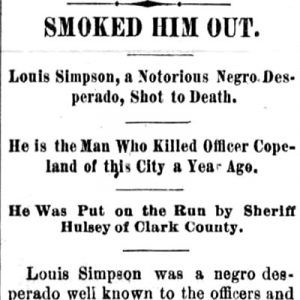calsfoundation@cals.org
Louis Simpson (Reported Lynching of)
Lynching research is often complicated by differing newspaper accounts of the events. This was the case with Louis Simpson, who was reportedly lynched in January 1887. While a report in the Arkansas Democrat indicated that Simpson, suspected of murder, had been pursued by a posse and shot in January 1887, and while he is listed as a being lynched on January 22 of that year by the Equal Justice Initiative, he was, in fact, eventually captured and imprisoned.
In 1880, Louis Simpson was living alone in Camden (Ouachita County). He was twenty-three, illiterate, and working as a day laborer. On January 24, 1887, the Arkansas Democrat reported that Simpson, a “negro desperado well known to the officers and people generally in this portion of Arkansas,” had been put in the penitentiary in 1883 for murder, the chief witness against him being an African American police officer, William Copeland of Little Rock (Pulaski County).
According to reports in the Appeal of St. Paul, Minnesota, and the Southern Standard of Arkadelphia (Clark County), Simpson soon became a trusty at the penitentiary, and while he was out on a pass one night in 1886, Copeland tried to arrest him. Simpson resisted and ran, and Copeland shot at him. It looked as if Simpson had fallen, and Copeland, holstering his gun, approached him. Simpson then hit him on the head, killing him. Simpson fled, and, using various aliases, traversed Clark, Ouachita, and Calhoun counties, pursued by Sheriff Hulsey of Clark County.
On January 8, 1887, the Southern Standard reported that on January 3, Hulsey had spotted Simpson on the flatcar of a train that was sitting at the siding in Arkadelphia. As he approached him, Simpson ran, and though Hulsey fired three shots, Simpson eluded him. The pursuit ended as night fell, but the following morning Hulsey and two others tracked him to Big Ditch, located about three miles from Arkadelphia. After a chase described as “one of the “liveliest…the sheriff [had] ever experienced,” Simpson ran into dense woods and again escaped. On January 24, the Arkansas Democrat published a similar report but added that after Simpson’s trail was lost in a swamp, his pursuers drove him to a cabin in Calhoun County, where they smoked him out and shot him. On January 29, the Southern Standard published an article refuting the Democrat’s claims, reporting that Hulsey had continued his search, hearing news of Simpson’s location twice since the Democrat’s report. According to the Standard, “If Simpson has really been killed, it must have occurred many days after his wonderful flight before Hulsey from the depot, instead of ‘the next morning’ as stated by the Democrat.”
In truth, Simpson had not been killed, and efforts to catch him continued. In September 1891, Sheriff Hamilton of Ouachita County located him in New Orleans and arrested him. Simpson reportedly confessed to murdering Copeland but said he had been helped by another inmate named John McMillan. McMillan was also arrested, but Simpson later testified that he alone had committed the crime. Simpson was tried and sentenced to hang on January 21, 1892. He appealed, however, and the case appeared before the Arkansas Supreme Court in April.
According to Simpson v. State, Arkansas (1892), Simpson admitted his crime but said he had attacked Copeland with a knife, not a heavy object. The court sent the case back to the district court, ruling that although “an unlawful killing is malicious, it does not presume that it is premeditated.” Thus the facts in the case did not support a verdict of first-degree murder, but rather one of murder in the second degree. In May 1892, the Pulaski County Circuit Court sentenced Simpson to fifteen years in the penitentiary. The outcome of the case was apparently controversial. According to the May 27, 1892, issue of the Southern Standard, at least one lawyer who was present for the sentencing “used vigorous language against the action of the supreme court in making itself a trial court, and declared the action of the court unconstitutional.” In 1900, Louis Simpson was still a resident of the Arkansas State Penitentiary.
For additional information:
“Bailey Sentenced.” Arkansas Gazette, April 3, 1892, p. 4.
“The City of Roses.” Appeal (St. Paul, Minnesota) December 19, 1891, p. 1.
“His Neck Saved.” Southern Standard (Arkadelphia, Arkansas), May 27, 1892, p. 1.
“A Lively Race and a Narrow Escape.” Southern Standard, January 8, 1887, p. 7.
“Murderer Caught after Five Years.” Appeal, September 19,1891, p. 1.
“The News in Brief.” Russellville Democrat, September 10, 1891, p. 1.
“Pulaski Circuit Court.” Arkansas Gazette, May 20, 1892, p. 6.
“Smoked Him Out.” Arkansas Democrat, January 24, 1887, p. 6.
“Was Louis Simpson Killed?” Southern Standard, January 29, 1887, p. 6.
Nancy Snell Griffith
Davidson, North Carolina
 Law
Law Post-Reconstruction through the Gilded Age, 1875 through 1900
Post-Reconstruction through the Gilded Age, 1875 through 1900 Louis Simpson Lynching Story
Louis Simpson Lynching Story 



Comments
No comments on this entry yet.